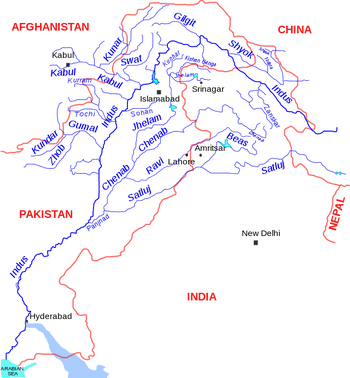Haro River
| Author:Laxman Burdak, IFS (Retd.) |

Haro (हरो) is the name of a river that flows through parts of Khyber Pakhtunkhwa and Punjab its valley in Abbottabad District in the North West Frontier Province of northern Pakistan. Haro River has been identified with the Rigvedic Arjikiya.
Location
Its coordinates are 33°46'8" N and 72°14'43" E in DMS (Degrees Minutes Seconds) or 33.7689 and 72.2453 (in decimal degrees). Famous Khanpur Dam has been built on this river at Khanpur in the Haripur Pakistan District to provide drinking water to the twin cities i.e. Islamabad (the capital of Pakistan) and Rawalpindi.
Tributaries
It is fed by four major tributaries:
- The Lora Haro, rising in the Murree Hills around Lora
- The Stora Haro, rising in the Galiat Malach hills
- Both Lora Haro and Satora Haro merge at Dotara near Jabri
- The Neelan, rising in the Nara Hills
- The Kunhad, draining the area of Siribang and Dubran.
Minor tributaries include the following rivulets.
This river joins Indus River near Ghazi Barotha Dam.
Jat clans
History
According to Alexander Cunningham[1] The position of the celebrated city of Taxila has hitherto remained unknown, partly owing to the erroneous distance recorded by Pliny, and partly to the want of information regarding the vast ruins which still exist in the vicinity of Shah-dheri. All the copies of Pliny agree in stating that Taxila was only 60 Roman, or 55 English, miles from Peucolaitis, or Hashtnagar, which would fix its site somewhere on the Haro river, to the west of Hasan Abdal, or just two days' march from the Indus.
Alexander Cunningham[2] writes that The Gakar chiefs hold the lower valley of the Jhelam, and the upper course of the Haro river to the south-west of Kashmir. They are all Muhammadans ; but their conversion is comparatively recent, as their names were Indian down to the invasion of Timur. Their occupation of these districts is of very early date ; but they are Turanians, and not Arians, as none but a Gakar will intermarry with a Gakar, a practice that is utterly repugnant to Hinduism, which permits no man to marry one of his own tribe. The Gakars also occupy several portions of the eastern Doab, as Guliana, near Gujar Khan, and Bugial, under the lofty hill of Balnath. But these districts do not properly belong to the hills, although they were subject to Kashmir at the time of Hwen Thsang's visit in the seventh century.
External links
References
Back to Rivers/Rivers in Pakistan/Rivers in Rigveda/Rivers in Pakistan

